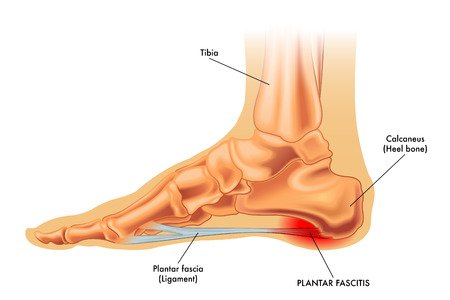All About Heel Spurs: Causes, Treatments and Prevention
Heel spurs are bony growths that form inside your foot. They develop below the back of your heel, where the bone meets your plantar fascia. That extra bone forms over time because of pressure; sometimes they’re painful, but not always. If heel spurs cause you pain, there are treatments we can recommend to improve symptoms and help you walk comfortably.
Heel Spurs and Plantar Fasciitis: What’s the Connection?
Heel spurs form at the spot where your heel bone and plantar fascia meet. Often, heel spurs develop alongside plantar fasciitis, because pressure can inflame your tendon and cause enough stress to trigger extra bone growth. But these two conditions are separate, and need different types of treatment.
Remember, you develop plantar fasciitis when you tear or stretch the ligament that runs along the bottom of your feet, from your heel to the ball of your foot. Symptoms include heel pain that’s worst when you first wake up. At first, your pain gets better throughout the day. But, without treatment, your heel pain may become chronic.
Now, heel spurs could form in response to the stress your body experiences when you have plantar fasciitis. But the heel spurs themselves aren’t usually painful. In most cases, the pain your feel from heel spurs is a result of changes in the fit of your shoes.
Causes and Prevention
Sometimes heel spurs form in response to stress and pressure. Other times, changes in your gait can trigger extra bone growth. Or, in certain situations, you may develop heel spurs if you keep tearing your heel bone covering.
There are several ways to help prevent heel spurs. If you’re a runner or athlete, try training on softer surfaces. Always wear shoes that offer the right arch support for your foot type, and add orthotics if shoes alone don’t offer enough protection.
Avoid going barefoot, even at home. Take pressure off your feet by elevating them when you can, and try to reach and maintain a healthy weight to remove more of the load from your heels. Most importantly, seek treatment for heel pain at the first sign of trouble, as this may help prevent heel spurs from forming.
Treating and Diagnosing Heel Spurs in Westfield, IN
We’ll usually diagnose heel spurs with an x-ray, since that’s the best way to detect unusual bone growth. Once we diagnose a heel spur, you’ll have several treatment options. At first, we’ll see if rest can take some of the pressure off your feet and resolve your heel pain. We may also recommend applying ice to the affected area, to help with pain and reduce inflammation.
In some cases, anti-inflammatory medications can help. And, as we mentioned, adding orthotics to your shoes can offer extra support and prevent heel spur pain and progression. You may be worried that you’ll need surgery to treat this bone growth. But we rarely suggest surgically removing these bony bumps. Instead, we help you relieve heel pain and move forward in ways that won’t trigger more painful symptoms.
Have you noticed a bump forming on the back of your heel? Don’t wait until you notice painful symptoms. Instead, schedule an appointment today with our Westfield podiatrist. We can offer tips and interventions that will keep pain away, and help you avoid future foot surgery.


